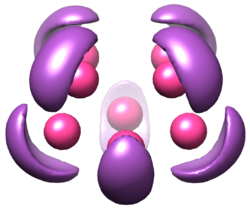Physics:Bismuth polycations
Bismuth polycations are polyatomic ions of the formula Bin+x. They were originally observed in solutions of bismuth metal in molten bismuth chloride.[2] It has since been found that these clusters are present in the solid state, particularly in salts where germanium tetrachloride or tetrachloroaluminate serve as the counteranions, but also in amorphous phases such as glasses and gels.[3][4][5][6][7] Bismuth endows materials with a variety of interesting optical properties that can be tuned by changing the supporting material.[8][9][10][11] Commonly-reported structures include the trigonal bipyramidal Bi3+5 cluster, the octahedral Bi2+6 cluster, the square antiprismatic Bi2+8 cluster, and the tricapped trigonal prismatic Bi5+9 cluster.
Known materials
Crystalline
Metal complexes
Structure and bonding
Bismuth polycations form despite the fact that they possess fewer total valence electrons than would seem necessary for the number of sigma bonds. The shapes of these clusters are generally dictated by Wade's rules, which are based on the treatment of the electronic structure as delocalized molecular orbitals. The bonding can also be described with three-center two-electron bonds in some cases, such as the Bi3+5 cluster. Bismuth clusters have been observed to act as ligands for copper[14] and ruthenium[15] ions. This behavior is possible due to the otherwise fairly inert lone pairs on each of the bismuth that arise primarily from the s-orbitals left out of Bi–Bi bonding.
Optical properties
The variety of electron-deficient sigma aromatic clusters formed by bismuth gives rise to a wide range of spectroscopic behaviors. Of particular interest are the systems capable of low-energy electronic transitions, as these have demonstrated potential as near-infrared light emitters. It is the tendency of electron-deficient bismuth to form sigma-delocalized clusters with small HOMO/LUMO gaps that gives rise to the near-infrared emissions. This property makes these species potentially valuable to the field of near-infrared optical tomography, which exploits the near-infrared window in biological tissue.[11]
References
- ↑ 1.0 1.1 1.2 Lindsjö, Andreas Fischer, Martin; Kloo, Lars (2005-02-01). "Improvements of and Insights into the Isolation of Bismuth Polycations from Benzene Solution – Single-Crystal Structure Determinations of Bi8[GaCl4]2 and Bi5[GaCl4]3" (in en). European Journal of Inorganic Chemistry 2005 (4): 670–675. doi:10.1002/ejic.200400466. ISSN 1099-0682.
- ↑ Day, Graeme; Glaser, Rainer; Shimomura, Noriyuki; Takamuku, Atsushi; Ichikawa, Kazuhiko (2000-03-17). "Electronic Excitations in Homopolyatomic Bismuth Cations: Spectroscopic Measurements in Molten Salts and an ab initio CI-Singles Study" (in en). Chemistry – A European Journal 6 (6): 1078–1086. doi:10.1002/(sici)1521-3765(20000317)6:6<1078::aid-chem1078>3.0.co;2-r. ISSN 1521-3765. PMID 10785828.
- ↑ Fujimoto, Yasushi; Nakatsuka, Masahiro (March 2001). "Infrared Luminescence from Bismuth-Doped Silica Glass" (in en). Japanese Journal of Applied Physics 40 (Part 2, No. 3B): L279–L281. doi:10.1143/jjap.40.l279. ISSN 1347-4065. Bibcode: 2001JaJAP..40L.279F. http://stacks.iop.org/1347-4065/40/L279.
- ↑ Dianov, Evgenii M.; Dvoyrin, V. V.; Mashinsky, V. M.; Umnikov, A. A.; Yashkov, M. V.; Gur'yanov, A. N. (2005). "CW bismuth fibre laser". Quantum Electronics 35 (12): 1083–1084. doi:10.1070/qe2005v035n12abeh013092. Bibcode: 2005QuEle..35.1083D.
- ↑ Zhou, Shifeng; Jiang, Nan; Zhu, Bin; Yang, Hucheng; Ye, Song; Lakshminarayana, Gandham; Hao, Jianhua; Qiu, Jianrong (2008-05-09). "Multifunctional Bismuth-Doped Nanoporous Silica Glass: From Blue-Green, Orange, Red, and White Light Sources to Ultra-Broadband Infrared Amplifiers" (in en). Advanced Functional Materials 18 (9): 1407–1413. doi:10.1002/adfm.200701290. ISSN 1616-3028.
- ↑ Razdobreev, Igor; El Hamzaoui, Hicham; Bouwmans, Géraud; Bouazaoui, Mohamed; Arion, Vladimir B. (2012-02-01). "Photoluminescence of sol-gel silica fiber preform doped with Bismuth-containing heterotrinuclear complex" (in EN). Optical Materials Express 2 (2): 205–213. doi:10.1364/ome.2.000205. ISSN 2159-3930. Bibcode: 2012OMExp...2..205R.
- ↑ Sun, Hong-Tao; Yang, Junjie; Fujii, Minoru; Sakka, Yoshio; Zhu, Yufang; Asahara, Takayuki; Shirahata, Naoto; Ii, Masaaki et al. (2011-01-17). "Highly Fluorescent Silica-Coated Bismuth-Doped Aluminosilicate Nanoparticles for Near-Infrared Bioimaging" (in en). Small 7 (2): 199–203. doi:10.1002/smll.201001011. ISSN 1613-6829. PMID 21213381.
- ↑ Cao, Renping; Peng, Mingying; Zheng, Jiayu; Qiu, Jianrong; Zhang, Qinyuan (2012-07-30). "Superbroad near to mid infrared luminescence from closo-deltahedral Bi3+5 cluster in Bi5(GaCl4)3" (in EN). Optics Express 20 (16): 18505–18514. doi:10.1364/oe.20.018505. ISSN 1094-4087. PMID 23038400. Bibcode: 2012OExpr..2018505C.
- ↑ Sun, Hong-Tao; Xu, Beibei; Yonezawa, Tetsu; Sakka, Yoshio; Shirahata, Naoto; Fujii, Minoru; Qiu, Jianrong; Gao, Hong (2012-08-28). "Photoluminescence from Bi5(GaCl4)3 molecular crystal" (in en). Dalton Transactions 41 (36): 11055–61. doi:10.1039/c2dt31167d. ISSN 1477-9234. PMID 22864825.
- ↑ 10.0 10.1 10.2 Sun, Hong-Tao; Sakka, Yoshio; Shirahata, Naoto; Gao, Hong; Yonezawa, Tetsu (2012-06-06). "Experimental and theoretical studies of photoluminescence from Bi2+8 and Bi3+5 stabilized by [AlCl4]− in molecular crystals" (in en). Journal of Materials Chemistry 22 (25): 12837. doi:10.1039/c2jm30251a. ISSN 1364-5501.
- ↑ 11.0 11.1 Sun, Hong-Tao; Zhou, Jiajia; Qiu, Jianrong (2014). "Recent advances in bismuth activated photonic materials". Progress in Materials Science 64: 1–72. doi:10.1016/j.pmatsci.2014.02.002.
- ↑ Kou, C. Y.; Zhuang, L.; Wang, G. Q.; Cui, H.; Yuan, H. K.; Tian, C. L.; Wang, J. Z.; Chen, H. (2015-10-27). "[TM13@Bi20]− clusters in three-shell icosahedral matryoshka structure: being as superatoms" (in en). RSC Advances 5 (112): 92134–92143. doi:10.1039/c5ra19194g. ISSN 2046-2069.
- ↑ 13.0 13.1 Groh, Matthias F.; Isaeva, Anna; Frey, Christoph; Ruck, Michael (2013-11-01). "[Ru(Bi8)2]6+ – A Cluster in a Highly Disordered Crystal Structure is the Key to the Understanding of the Coordination Chemistry of Bismuth Polycations" (in en). Zeitschrift für Anorganische und Allgemeine Chemie 639 (14): 2401–2405. doi:10.1002/zaac.201300377. ISSN 1521-3749.
- ↑ Knies, Maximilian; Kaiser, Martin; Isaeva, Anna; Müller, Ulrike; Doert, Thomas; Ruck, Michael (2018). "The Intermetalloid Cluster Cation (CuBi8)3+" (in en). Chemistry – A European Journal 24 (1): 127–132. doi:10.1002/chem.201703916. ISSN 1521-3765. PMID 28977714.
- ↑ Groh, Matthias F.; Isaeva, Anna; Frey, Christoph; Ruck, Michael (2013-11-01). "[Ru(Bi8)2]6+ – A Cluster in a Highly Disordered Crystal Structure is the Key to the Understanding of the Coordination Chemistry of Bismuth Polycations" (in en). Zeitschrift für Anorganische und Allgemeine Chemie 639 (14): 2401–2405. doi:10.1002/zaac.201300377. ISSN 1521-3749.
 |



